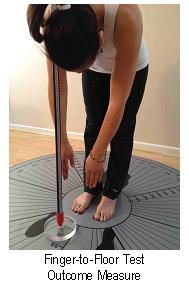Fingertip-to-Floor Test
Reference:Ekedahl H, et al Fingertip-to-Floor Test and Straight Leg Raising Test: Validity, Responsiveness, and Predictive Value in Patients With Acute/Subacute Low Back Pain. Arch Phys Med Rehabil. 2012 Dec;93(12):2210-5.
The patient is asked to bend forward and attempt to reach for the floor with their fingertips. The PT then measures the distance between the patient’s right long finger and the floor using a measuring tape or the STARpole. Can a test get any simpler than that?
I use the fingertip-to-floor (FTF) test as an outcome measure on the majority of my patients presenting with LBP for the simple reason that forward bending is one of the more painful and limited movements, especially in those with neural symptoms.
If the FTF test is limited by pain, the location and pain score (? / 10) is documented.
This longitudinal study involved patients with acute and subacute LBP with or without radicular symptoms. They demonstrated that a change in the FTF test was significantly correlated to the 1-month and 1-year change in Roland Morris Disability Questionnaire (RMDQ).
The more commonly used SLR test showed a weak relationship to RMDQ.
They basically concluded that for patients with LBP the FTF had good reliability and validity with even better validity in those with radicular pain. The minimal detectable change for FTF test was shown to be 4.5cm. I personally look for a change of at least 10cm.
There are no “normative” values for the FTF test, as forward bending flexibility is obviously highly variable among all of us.
Clinical Relevance: Now you have an actual physical outcome measure that is almost as good as the RMDQ!
Posted on: March 23, 2013
Categories: Lumbar Spine


